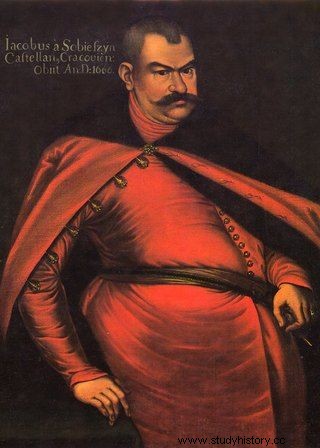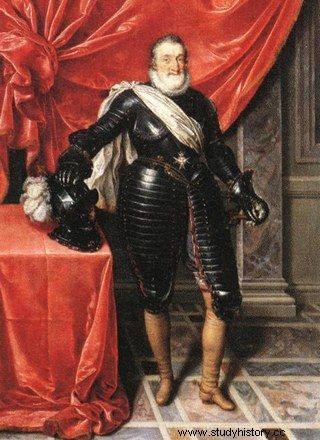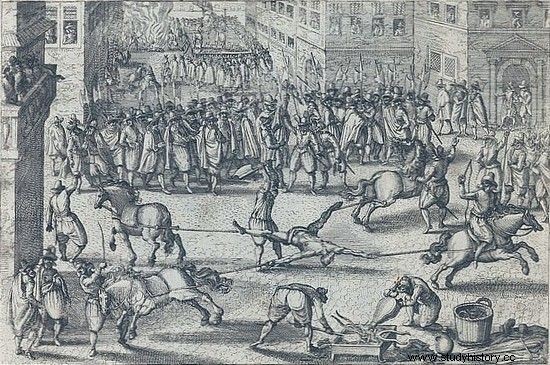The day of May 14, 1610, went down indelibly in the history of modern France. King Henry IV Bourbon was stabbed to death at rué de Férronnerie. A witness of the dramatic events, and in the eyes of the Parisian people also the accused, was Jakub Sobieski - a Polish magnate, and in the future the father of King John.
At the moment we are interested in, Jakub was only 20 years old, and he was visiting France as part of an educational trip throughout Western Europe. He had known the French monarch earlier, in 1607, during peace negotiations with the United Provinces of the Netherlands, which were taking place at the French court.
Despite his young age, the Lublin voivode was introduced to the plans of Henry IV to take over scheda after the childless deceased prince Jülich-Kleve, and then participated in the French armed expedition under the command of Marshal Louis Galuzzo de l'Hopital.

Jakub Sobieski in full splendor in a portrait from the time when he was already a mature man.
Among other things, it was this initiative that convinced the ruler of Spain, as well as the emperor, that King Henry must finally be rendered harmless. The unsuccessful attempt to murder the monarch at the instigation of the viceroy of Milan - Count Fuenates - was made by a secret agent of Savoy, La Fin la Noclé. The plan failed because the agent had betrayed his principals. However, France's neighbors were not going to let go.
An assassination attempt on the king… organized by Poles?
Thus, we come to that unfortunate day of May 14. Henry left the royal palace in the Louvre in his carriage and set off for the Bastille. The purpose was to inspect war preparations.
On the way back, at the junction of Rué des Halles and St. Denis, the street was blocked by a cart carrying barrels of wine. Then, as Sobieski recalled in his memoirs 30 years later, the main actor of this tragedy jumped onto the royal carriage - a murderer, a certain François Ravaillac:
Rawaliak jumped towards the wing, where no one was sitting, and immediately stabbed the king with a knife twice in venam cavam, he hit and blood spilled from the wounds and from his mouth and ears . The poor king would say no more, but these words "My God, behold, I am already dead, I am already dying!" - and so luctuoso fato did his days there .

The assassination of Henry IV in the painting by Charles-Gustave Housez (source:public domain).
Sobieski witnessed the murder and painfully survived the king's death. He considered the monarch to be an educated, reasonable, brave man, full of social character, yet at the same time craving for power and leadership in the world. Meanwhile, it was he, along with his peers and compatriots - Mikołaj Krzysztof and Stanisław Albrycht Radziwiłł - who became the target of harassment from Parisians immediately after May 14.

Here is Henry IV, reached by the hand of the assassin.
The people of the capital mistakenly believed that Poles, as Catholics, prepared the attack! The abbot of Saint Genowefa - father d'Escurey asked Sobieski to give him his belongings for safekeeping during the turmoil. Tumult, looting taverns and houses, finally street fighting must have terrified the foreigners.
Scrambled eggs with meat
Sobieski became an involuntary observer of the next installment of the drama - the judgment of the murderer. In his diary, he notes that François Ravaillac of Angoulême in Provence was an admirer of the doctrine of tyranicide created by a Spanish Jesuit and historian - father Juan de Mariana. He is expressed as an insane, melancholic, obsessed with satanic lust.
The act of political murder was met with a harsh sentence from the Paris Parliament, which sentenced Ravalliac to death. His house in his hometown was to be burned down, and his descendants up to 4 generations were to be condemned from acquiring municipal and state dignities. The work of Jesuit Juan de Mariana was publicly ordered to be burned and forbidden to be printed.
However, this did not prevent a self-generated "cult" of the murderer. Sobieski reports that after the execution, parts of Ravalliac's body were collected by the townspeople and treated as relics. He also reported an unusual form of this "adoration" used by the host of the house where he stayed with Piotr Branicki from Rusiec.

François Ravaillac was severely punished for his act, dying in terrible torment.
The host, a bookbinder by profession, added body parts to the scrambled eggs and ate them, also encouraging his guests to do so :
This host, seemingly sedate, with a great beard, also brought some tricks of this Rawaliak's body and fry them in scrambled eggs from the venom and ate them for what my eyes and the eyes of JM Mr. Branicki were watching. He even dared to ask both of us to his banquet to help him eat it. Polish nobles, in an equally unusual way, thanked the host:.
